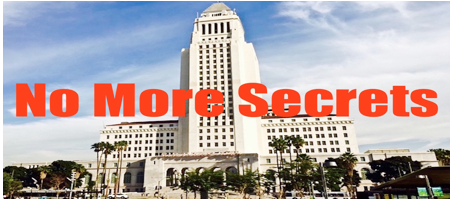CommentsPEOPLE’S VOICE--When it comes to policy making for planning and land use in LA, politicians and top city bureaucrats don’t want you to know what secret moves they’re orchestrating behind the scenes to help their deep-pocketed developer pals. It was true in 2008, and it’s just as true in 2016. Startlingly so.
That’s what one quickly realizes when reading the excellent 2008 LA Weekly feature story, “Bitter Homes & Gardens: City Hall’s ‘Density Hawks’ Are Changing LA’s DNA.” It’s essential reading for anyone who wants to understand how development works in Los Angeles, and it’s another installation of “The Bulldozer Files,” in which we highlight important press coverage of LA’s ongoing land-use wars.
Just like today, the LA Weekly found in 2008 that City Hall pols and bureaucrats were approving variances and zoning changes at eye-popping rates that few people knew about. Those approvals were helping developers, who are major campaign contributors in LA, become even richer. The paper noted: “The constant overriding of zoning protections has indeed been relentless — a binge of ‘zoning variances’ and ‘zone changes’ granted by longtime Zoning Administrator Michael LoGrande, a little-known official who is the rear admiral of a pro-density flotilla inside City Hall that long predates [Mayor Antonio] Villaraigosa’s administration.”
The variances and zone changes — quite simply, permissions to skirt existing rules — are granted on a case-by-case basis, and LoGrande hands them out like candy. LoGrande did not return numerous phone calls from the LA Weekly. Four biweekly Planning Department reports, randomly selected by the Weekly from March, June, September and December 2007, show that requests to increase housing density or square footage rolled in at about 260 annually, slowing only as the mortgage crisis hit. Retired Zoning Administrator Jon Perica explains that while the sought-after density increases are subjected to design, environmental and compatibility review, “the Planning Department historically approves about 90 percent.”
For anyone paying attention, and very few people are, LoGrande’s decisions — buttressed by the rulings of seven area planning commissions populated with Villaraigosa’s appointees — are why some corners of the city are taller and more congested than 10 years ago, even neighborhoods whose legally binding zoning plans were supposed to achieve the opposite.
What’s worse, politicians and bureaucrats regularly pushed forward land-use policies that dramatically altered neighborhoods with little public debate or transparency. One of the few elected officials that spoke out about such secret governing was longtime LA County supervisor Zev Yaroslavsky.
The LA Weekly wrote: “In fact, Angelenos don’t have a clue what’s been happening, or what’s coming. In the 32 months since Villaraigosa was elected, for example, the Los Angeles Times and the Daily News have written only four stories about a plan to allow apartments without parking in order to squeeze in more units. The phrase “SB 1818” has appeared in just 14 articles. The mayor’s czar of zoning variances, Michael LoGrande, is virtually unknown — mentioned just six times in Los Angeles print media in the past two years. And the “superpublic” hearings cited by Blumenfeld were attended almost exclusively by lobbyists, a few activists and the occasional curious neighbor.
“’There should be a debate!’ Yaroslavsky wheezes, a victim of allergies, dabbing his nose with a handkerchief.
“The proponents of the density hawks, including the director of the Planning Department, and the real estate industry, and the L.A. Area Chamber of Commerce — they had the audacity to say that they negotiated the plan [with homeowners]. Not true, there wasn’t one neighborhood group that knew about it!”
Today, any frontline community activist will tell you that such skullduggery still happens at LA City Hall, where politicians and developers continue to manipulate LA’s rigged and broken development-approval system for their own self interests.
After years of chicanery, it’s either naive or insane or both to think that crew will suddenly reform itself.
It’s why we need a community-based, citywide solution such as the Neighborhood Integrity Initiative. The measure will finally start the process of truly changing the unfair development-approval system by giving citizens more substantive tools to protect their neighborhoods from overdevelopment and the numerous quality of life impacts that come with it. Such as traffic gridlock, the destruction of neighborhood character and the displacement of longtime residents — many of whom are working-class families and senior citizens — through gentrification.
The Neighborhood Integrity Initiative, for example, stops the practice of developers writing their own environmental impact reports — an obvious and troubling conflict of interest. An EIR studies how a new project, such as a 27-story skyscraper proposed in the middle of a low-slung, working-class neighborhood in Koreatown, affects an existing community.
It’s no wonder that developers and local politicians are worried sick that our community-based movement and citywide ballot measure will actually succeed. We’ll change the old way of doing business that brings them millions in profits and campaign contributions.
So read more of the Weekly article. You’ll know why our fight is so important.
And please join the Neighborhood Integrity Initiative movement by clicking to our Act page right now, and follow and cheer our efforts on Facebook, Twitter and Instagram. You can also send us an email at [email protected].
Together, we can create the change that LA needs!
(Patrick Range McDonald writes for 2PreserveLA.org.) Prepped for CityWatch by Linda Abrams.
Sidebar
Our mission is to promote and facilitate civic engagement and neighborhood empowerment, and to hold area government and its politicians accountable.

 CityWatch Los Angeles
Politics. Perspective. Participation.
CityWatch Los Angeles
Politics. Perspective. Participation.
11
Thu, Dec














